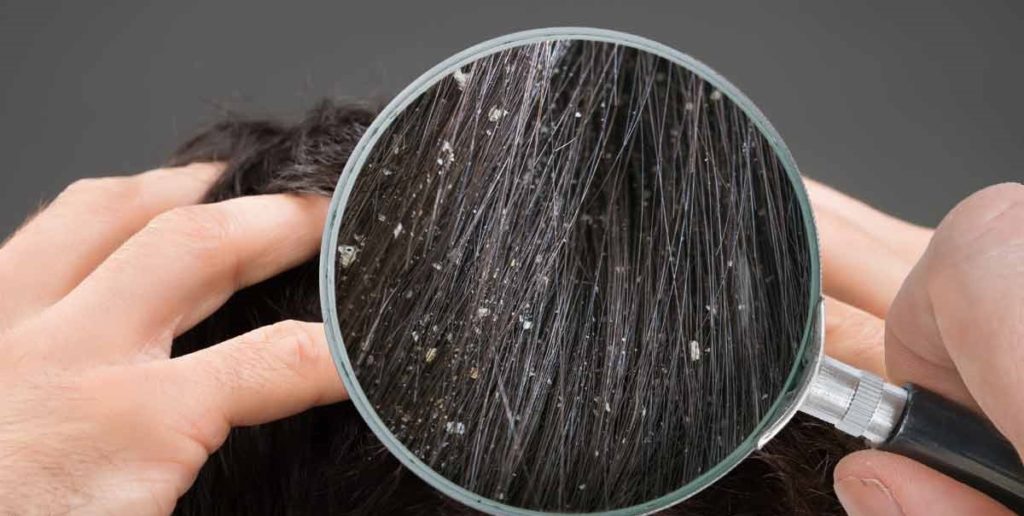
Simple ways to get rid of Dandruff
Dry white flakes of skin, on your scalp is known as dandruff.
-
- It is not a health risk, but is a source of embarrassment.
- Some people have the wrong notion that it is because of bad hygiene or washing the hair often – this is a false belief. It is just that people having dandruff shed more skin then others.
- However some dermatologists suggest that is caused by a yeast fungus that is believed to breed in a combination of sebaceous oil and dead skin cells.
-
CAUSES:
- A family history of dandruff.
- Excessive sweating of the scalp.
- Excessive mental and physical stress.
- Use of alkaline soaps.
- Cold dry winter season.
- Psoriasis of scalp.
- Seborrhoeic dermatitis.
- Improper carbohydrate and sugar consumption.
- Nutrient deficiencies – B-complex, essential fatty acids, selenium.
-
SIGN AND SYMPTOMS:
- Flakes of skin which may be small and white or large greasy and yellow.
- Itching on scalp, eyebrows, nose or ears.
- It can be worse in winters.
-
DIETARY MANAGEMENT:
Avoid:
- Avoid fatty and oily food.
- Avoid dairy products (except yoghurt) – cheese, cottage cheese and seafood.
- Avoid sugar, white flour and chocolate
- Avoid excess alcohol.
- Avoid stress.
- Even though dandruff is dry flaking skin do not normally apply excessive oil as it may provide an environment for yeast to breed.
-
DO:
- Add one tea spoon of vinegar to the rinsing water after washing your hair.
- Before washing your hair, apply a mixture of 8 table spoon of pure organic peanut oil and 2 table spoon lemon juice and massage into the scalp. Leave it for 10-15 minutes then shampoo.
- You can replace oil with coconut milk or coconut water; leave it over night and shampoo.
- Wash hair with natural, herbal ingredients rather than chemical – take mixture of amla (Indian goose berri) powder, aritha (sapindus Laurifotius) powder and shikakai (Acacia Concinna) powder, soak it in water over night and wash hair with the mixture.
- Practice yoga, helps in relieving stress and will increase blood circulation.
- Natural live yoghurt is recommended as a natural conditioner.
- Avoid harsh hair dyes and hair creams.
- Softly massage your scalp when you shampoo or oil. This will help blood circulation and prevent skin from drying and cracking.
-
CONSUME:
- Drink plenty of water.
- Eat large percentage of your diet as raw fruits and vegetables.
- Consume (3-4) – nuts and seeds daily.
- Consume linseed oil – 2 table spoon.
- Consumption of Aelo vera juice is also helpful.
- Consume Kelp and Japanese sea plants frequently as they supply many minerals like iodine which are better for hair growth and healing of the scalp.
- Increase intake of zinc in diet:
– Shellfish, beef and other red meats, eggs and seafood, milk and milk products, nuts, sea plants especially Japanese sea. - Consume diet rich in antioxidants like Vitamin A, Vitamin C and Vitamin E.
- Increase intake of foods that contain PUFA`s (poly unsaturated fatty acids): flax / linseed oil is the richest source of PUFA`s. Other oils that contain PUFA`s are safflower oil, soybean oil, maize oil, sesame oil, olive oil. As all oils are high in fats, its consumption should be limited. The intake of oils should not exceed 20gms a day.
- Increase intake of foods that contain PUFA`s (poly unsaturated fatty acids): flax / linseed oil is the richest source of PUFA`s. Other oils that contain PUFA`s are safflower oil, soybean oil, maize oil, sesame oil, olive oil. As all oils are high in fats, its consumption should be limited. The intake of oils should not exceed 20gms a day.
- Consume lots of Selenium:
– Fish, shellfish, eggs, red meat, chicken, liver, grains, Brazil nuts, garlic, wheat germ and brewer`s yeast. - Consume lots of Vitamin B complex:
– Liver, kidney, pancreas, yeast (Brewer’s yeast), lean meat especially pork, fish, dairy products, poultry, egg, shrimps, crabs and lobsters.
– Milk and milk products, green leafy vegetables, legumes, nuts, whole grain cereals.
– Carrots, bananas, avocado, raspberries, artichoke, cauliflower, soy flour, barley, cereals, pasta, whole grains, wheat barn like rice and wheat germ, dried beans, peas and soybeans.
